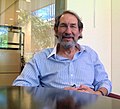File:Geoffrey West.jpg

本预览的尺寸:661 × 600像素。 其他分辨率:264 × 240像素 | 529 × 480像素 | 846 × 768像素 | 1,128 × 1,024像素 | 1,322 × 1,200像素。
原始文件 (1,322 × 1,200像素,文件大小:559 KB,MIME类型:image/jpeg)
文件历史
点击某个日期/时间查看对应时刻的文件。
| 日期/时间 | 缩略图 | 大小 | 用户 | 备注 | |
|---|---|---|---|---|---|
| 当前 | 2007年7月30日 (一) 09:53 |  | 1,322 × 1,200(559 KB) | FlickreviewR | Replacing image by its original image from FlickR |
| 2007年7月30日 (一) 03:44 |  | 1,024 × 930(547 KB) | PDH | {{Information |Description= "As animals get bigger, from tiny shrew to huge blue whale, pulse rates slow down and life spans stretch out longer, conspiring so that the number of heartbeats during an average stay on Earth tends to be roughly the same, arou |
文件用途
以下页面使用本文件:
全域文件用途
以下其他wiki使用此文件:
- ar.wikipedia.org上的用途
- azb.wikipedia.org上的用途
- de.wikipedia.org上的用途
- en.wikipedia.org上的用途
- en.wikiquote.org上的用途
- fa.wikipedia.org上的用途
- fa.wikiquote.org上的用途
- fr.wikipedia.org上的用途
- gd.wikipedia.org上的用途
- hy.wikipedia.org上的用途
- it.wikipedia.org上的用途
- ja.wikipedia.org上的用途
- ko.wikipedia.org上的用途
- nl.wikipedia.org上的用途
- pa.wikipedia.org上的用途
- pl.wikipedia.org上的用途
- pnb.wikipedia.org上的用途
- sr.wikipedia.org上的用途
- sv.wikipedia.org上的用途
- vi.wikipedia.org上的用途

